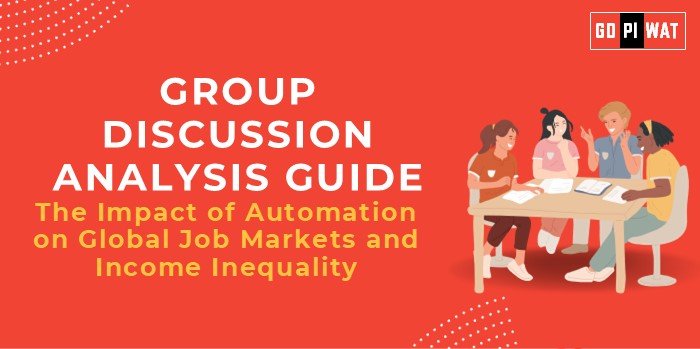📋 Group Discussion Analysis Guide: The Impact of Automation on Global Job Markets and Income Inequality
🌐 Introduction to the Topic
Opening Context: Automation is reshaping industries worldwide, affecting labor markets and intensifying discussions on economic inequality. From advanced AI to robotics, these innovations promise efficiency but also pose risks to job security and equitable wealth distribution.
Topic Background: Automation’s journey began with mechanization during the Industrial Revolution. In recent years, breakthroughs in machine learning, robotics, and AI have catalyzed the Fourth Industrial Revolution, creating unprecedented shifts in global employment landscapes.
📊 Quick Facts and Key Statistics
- Automation Growth: 45% of current job tasks could be automated using existing technologies (McKinsey Global Institute, 2023).
- Job Displacement: By 2030, automation could displace 400 million workers globally (World Economic Forum).
- Income Inequality: The global Gini coefficient increased by 1.5% in the past decade, correlating with tech adoption (World Bank).
- AI Market Value: Expected to reach $1.5 trillion by 2030, signaling increasing investment and adoption.
👥 Stakeholders and Their Roles
- Governments: Regulating automation, implementing worker reskilling programs, and addressing inequality.
- Corporations: Adopting automation for efficiency while balancing workforce retention.
- Workers/Unions: Advocating for job protection, reskilling opportunities, and fair wages.
- NGOs/Think Tanks: Researching policy solutions and highlighting socio-economic impacts.
- Global Organizations: The UN and ILO focus on inclusive technological development and global labor standards.
🏆 Achievements and Challenges
✔️ Achievements:
- Efficiency Gains: Companies using AI report up to 30% productivity increases (MIT Tech Review, 2023).
- New Job Creation: Automation spurred over 97 million new roles, such as AI trainers and data analysts (WEF).
- Global Integration: Countries like Japan and Germany successfully integrated robotics without major job losses.
⚠️ Challenges:
- Job Displacement: Manufacturing and retail sectors are experiencing severe workforce reductions.
- Skill Gaps: Only 20% of workers in emerging markets are equipped for high-tech roles.
- Income Inequality: Automation benefits highly skilled workers disproportionately, exacerbating wealth gaps.
🌍 Global Comparisons:
- Estonia: Seamlessly transitioned to e-governance, minimizing employment disruption.
- United States: The Rust Belt region highlights the dangers of ignoring automation-induced job losses.
📚 Case Studies:
- Germany’s Industry 4.0: Successfully integrated robotics with robust worker retraining programs.
- India’s IT Sector: Automation has driven job growth in urban hubs while creating rural disparities.
🗣️ Structured Arguments for Discussion
- Supporting Stance: “Automation enhances productivity, drives innovation, and creates new industries that fuel economic growth.”
- Opposing Stance: “The rapid adoption of automation risks exacerbating unemployment and deepening socio-economic divides.”
- Balanced Perspective: “While automation boosts productivity, inclusive policies are essential to mitigate its societal downsides.”
🔍 Effective Discussion Approaches
- Opening Approaches:
- Start with a statistic on job displacement to highlight urgency.
- Use a case study, like Germany’s Industry 4.0, to set a balanced tone.
- Counter-Argument Handling:
- Acknowledge displacement risks but emphasize retraining successes.
- Cite global examples to argue that automation can coexist with job security.
📈 Strategic Analysis of Strengths and Weaknesses
- Strengths: Increased productivity, cost savings, and job creation in tech sectors.
- Weaknesses: Skill gaps, displacement in traditional jobs, and rising inequality.
- Opportunities: Reskilling programs, policy frameworks, and global collaboration.
- Threats: Resistance from labor groups, ethical concerns about AI, and uneven adoption.
🎓 Connecting with B-School Applications
Real-World Applications: The topic links to business innovation, HR strategies, and policy formulation projects.
Sample Interview Questions:
- “How should businesses balance automation adoption with employee welfare?”
- “What strategies can reduce automation-induced inequality?”
Insights for Students:
- Automation’s dual impact offers opportunities for impactful internships in AI ethics or labor economics.
- Leverage this knowledge for projects on innovation-driven economic policies.


